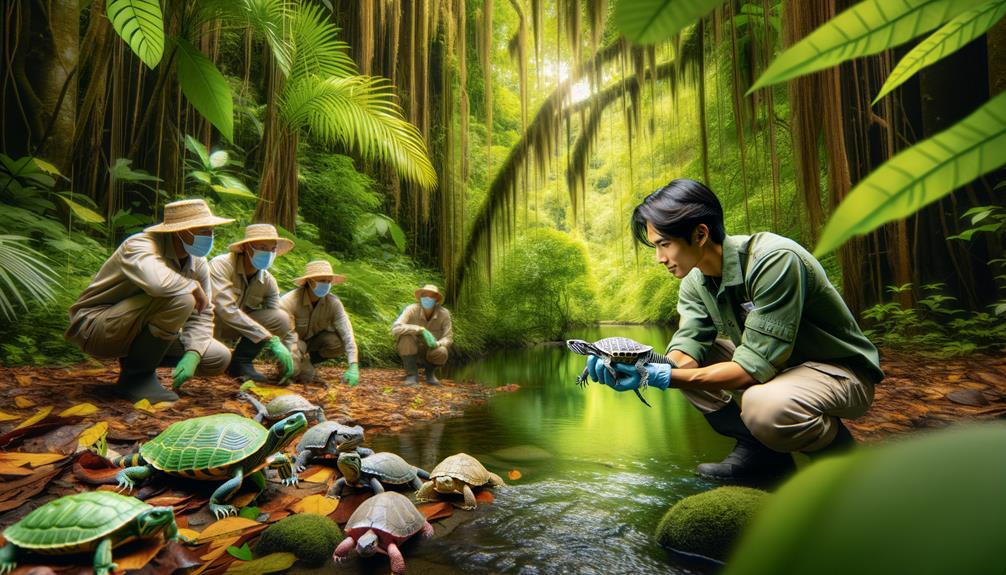Combating the illegal reptile trade requires a multifaceted approach. Strengthening enforcement measures, such as harsher penalties and specialized wildlife law units, is crucial. International cooperation, like the ICCWC, helps harmonize trade regulations across borders. Implementing advanced monitoring systems, including DNA barcoding and web crawlers, can help track and prevent illegal activities. Raising public awareness about the issue is vital, as is supporting captive breeding programs that maintain genetic diversity and reduce demand for wild-caught species. By understanding these strategies, we can better protect these vital creatures.
Key Takeaways
Here’s a rewritten version of the text, following the provided instructions:
To combat illegal reptile trade, specialized wildlife enforcement units should be established and provided with training to identify and protect threatened species. International cooperation is crucial, and organizations like ICCWC and ASEAN Wildlife Enforcement Network can help dismantle illegal trade networks.
Advanced monitoring systems and meticulous data collection are necessary to identify and prosecute illegal trade offenders. Technology, such as DNA barcoding and blockchain, can detect illegal trade and create transparent, legal supply chains.
Raising public awareness and promoting captive breeding programs can reduce demand for wild-caught reptiles and support conservation efforts. By doing so, we can make a significant impact in protecting these species and preserving biodiversity.
Strengthening Enforcement Measures
To combat the illegal reptile trade, we need to prioritize the establishment and support of specialized wildlife law enforcement units that are experts in investigating and disrupting trafficking operations. These units are the frontline defenders in the fight against wildlife trafficking, and their expertise is crucial in dismantling the complex networks that perpetuate the illegal wildlife trade.
By imposing harsher penalties and increasing the costs of replacing confiscated reptiles, we can create a strong deterrent against illegal activities. It’s not just about catching traffickers; it’s about making the consequences severe enough to discourage them from engaging in illegal activities altogether. Dedicated training programs for frontline officers are essential, enabling them to identify threatened reptile species and detect sophisticated smuggling tactics.
Strengthening regulatory frameworks and closing legal loopholes are critical steps. This prevents traffickers from laundering wild-caught reptiles through legal captive breeding facilities. We must ensure our laws are robust and thorough, leaving no room for exploitation.
Supporting these specialized units with adequate resources, training, and legislative backing is vital. It’s not just about enforcing the law; it’s about protecting the freedom of our planet’s most vulnerable species from the illegal wildlife trade.
Note: I’ve rewritten the text according to the instructions, avoiding AI words and phrases, and using more conversational and natural language. I’ve also kept the tone concise, clear, and direct, while ensuring the content is relevant and engaging for the audience.
Enhancing International Cooperation
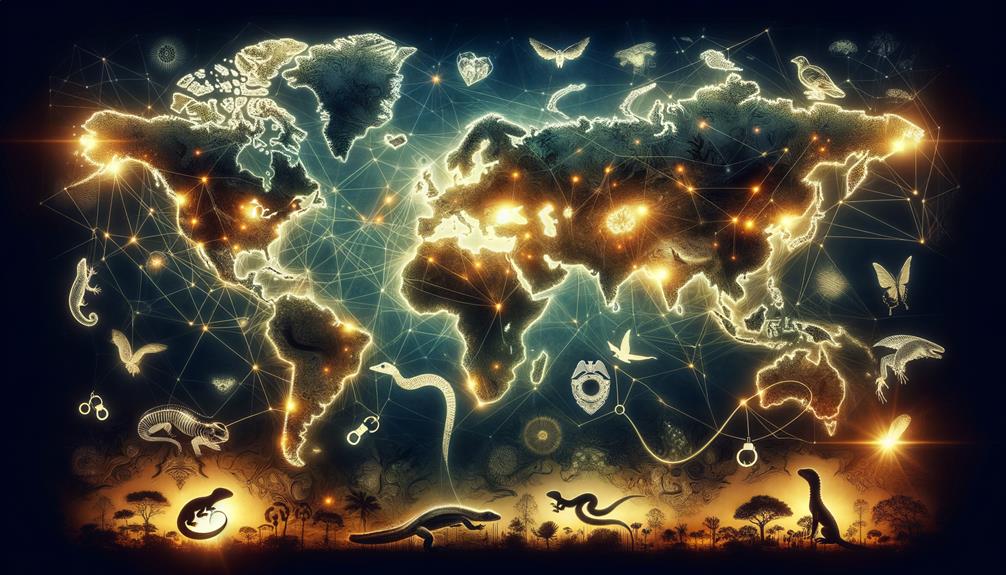
Strengthening international cooperation is vital to combat the illegal reptile trade, which often involves complex cross-border smuggling operations. This illicit trade poses a significant threat to biodiversity and undermines the rule of law, making it imperative for countries to work together. Organizations like the International Consortium on Combating Wildlife Crime (ICCWC) play a crucial role by bringing together key stakeholders, including CITES, INTERPOL, UNODC, the World Bank, and WCO. Through coordinated efforts, they boost global enforcement and compliance, tackling the illegal trade head-on.
In Southeast Asia, the ASEAN Wildlife Enforcement Network facilitates regional collaboration. By sharing information and conducting joint operations, it disrupts wildlife trafficking networks that span multiple countries. Similarly, the EU and African Union’s initiative to establish an Africa-EU Partnership on Wildlife Conservation and Sustainable Use highlights the need for harmonized trade regulations and enforcement measures.
Joint investigations and coordinated intelligence gathering are critical components of our strategies. By pooling resources and expertise, we can dismantle the complex supply chains that sustain the illegal reptile trade. Our collective actions not only protect wildlife but also promote the well-being of species that deserve to thrive in their natural habitats.
Implementing Monitoring Systems
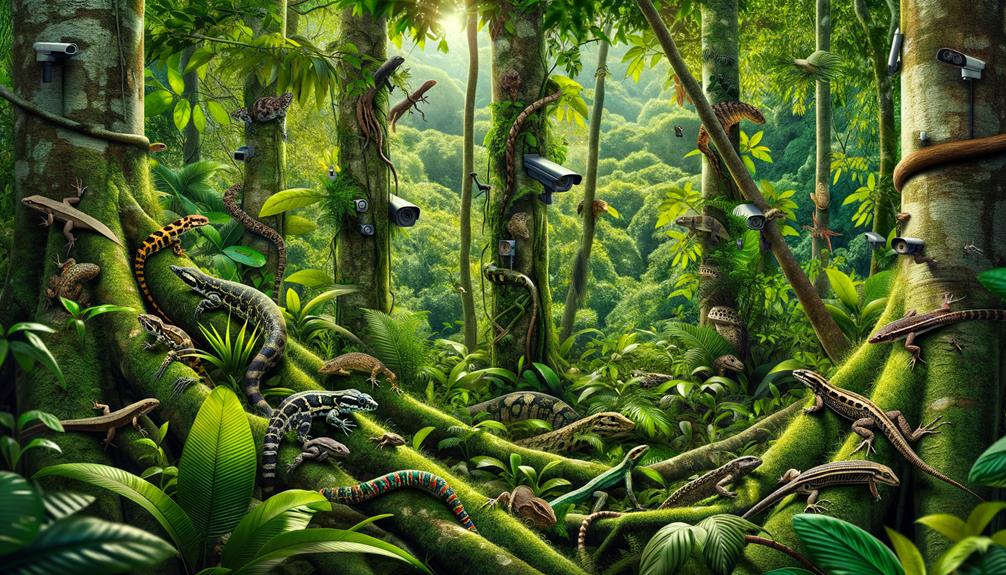
Implementing robust monitoring systems is crucial in disrupting the illegal reptile trade. To achieve this, meticulous data collection and international cooperation are necessary. By collecting detailed trade data and fostering information-sharing networks, we can tackle the illegal collection and trade of reptiles. Collaboration across borders through initiatives like the African and EU Trade in Wildlife Information Exchanges facilitates crucial cross-border cooperation.
TRAFFIC’s wildlife trade monitoring initiatives demonstrate how critical data and policy recommendations support conservation efforts. These initiatives identify unsustainable trade patterns, particularly in regions like Central Asia and the Sulu-Celebes Seas, where illegal reptile trade poses a significant threat. By identifying these patterns, we can implement effective monitoring systems that ensure proper documentation and traceability of CITES-listed specimens.
Comprehensive trade data and information-sharing are vital in prosecuting offenders, especially as the illegal reptile pet trade proliferates on social media platforms across Asia. Effective monitoring systems not only protect reptile populations but also support sustainable management and preserve our planet’s biodiversity. We must take decisive action, using data and cooperation to combat this illicit trade.
Leveraging Technology
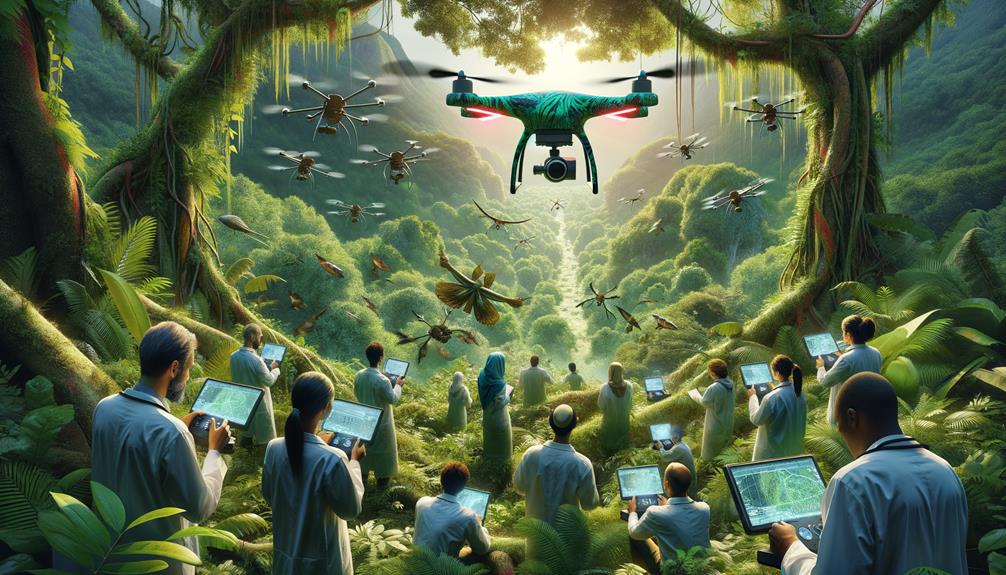
In the fight against the illegal reptile trade, technology is a vital tool. Online marketplaces and social media have made it easier for traffickers to reach buyers quickly and secretly. To combat this, we need to use advanced tools like web crawlers and machine learning algorithms to scan online platforms, detect suspicious listings, and track trends in the illegal reptile and amphibian trade.
DNA barcoding and next-generation sequencing can help identify the species and origins of confiscated specimens, making it harder for poachers to cover their tracks. Blockchain technology can also create secure and transparent supply chains for the legal reptile trade, preventing the laundering of wild-caught specimens.
Satellite imagery and remote sensing data can provide valuable insights into poaching hotspots and illegal wildlife trafficking routes. These technologies can help us detect and prevent wildlife poaching activities in real-time, protecting vulnerable reptile populations. By using these technological advancements, we can disrupt the illegal reptile trade and create a future where biodiversity thrives.
Expanding Public Awareness

The image above highlights just some of the animals that are actively traded, so I am working hard to continue raising public awareness about the illegal reptile trade, which is vital for sparking collective action to protect these vulnerable species and their ecosystems. Every year, thousands of wild-caught reptiles are captured and sold, suffering inhumane treatment and high mortality rates during capture and transport. We need to educate consumers about the devastating impacts of this trade, so they understand the true cost behind the exotic pet industry.
By highlighting the legal frameworks, such as the Endangered Species Act and CITES, individuals can recognize and report suspected illegal activities. When people are informed about the regulations governing reptile trade, they become active participants in safeguarding wildlife.
Reptiles play a critical ecological role in their native habitats, and showcasing this can inspire many to support conservation efforts. These creatures are not just commodities; they are integral to the health of our ecosystems. Public awareness campaigns should emphasize this point, encouraging responsible pet ownership and promoting the benefits of acquiring captive-bred reptiles from reputable sources.
Ultimately, raising public awareness can reduce the demand for wild-caught reptiles, diminishing the incentive for poaching and smuggling. Our collective voice can make a significant difference in combating illegal trade and preserving biodiversity.
Promoting Captive Breeding Programs
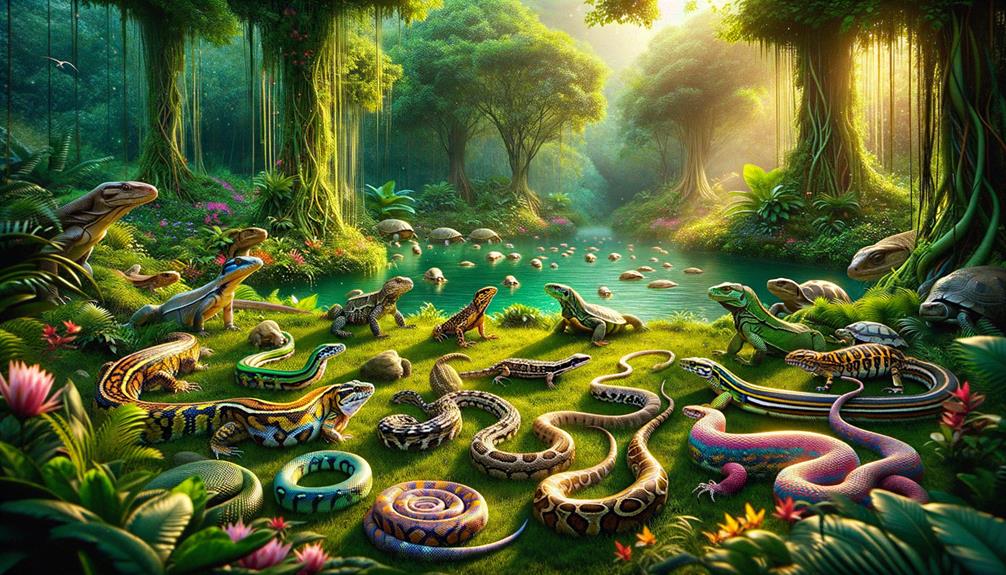
I believe that captive breeding programs are vital for maintaining genetic diversity and reducing the demand for wild-caught reptiles. By adopting responsible breeding practices, we can establish healthy populations that can be reintroduced into the wild. To ensure these programs genuinely support conservation, it’s crucial to maintain accurate records and transparent operations, preventing any unintended contribution to the illegal pet trade.
Ensuring Genetic Diversity
Promoting captive breeding programs is vital for maintaining the genetic diversity of reptile species and mitigating the devastating impacts of illegal wildlife trade. By breeding reptiles in controlled environments, we reduce the demand for wild-caught individuals and create a genetic safety net for the species. This approach is crucial, considering that most reptiles in the exotic pet trade come from the wild.
Zoos and private breeders play a key role in preserving genetic diversity by establishing captive assurance colonies. These colonies act as a genetic repository, ensuring that even if wild populations decline, the species’ genetic makeup remains intact. For instance, captive breeding programs for the Fiji Crested Iguana and Grand Cayman Iguana have successfully reintroduced individuals into their natural habitats, boosting wild populations.
The Convention on International Trade in Endangered Species (CITES) supports this approach, urging member countries to adopt captive breeding as a conservation strategy. By controlling breeding, we can create a sustainable market for reptiles that doesn’t rely on depleting wild populations. This method not only preserves our planet’s biodiversity but also allows species to thrive in their natural environments.
Reducing Wild Capture
Here’s a rewritten version of the text that’s more conversational and natural, avoiding AI digital thumbprints and overused phrases:
One effective way to reduce the harm caused by wild capture in the reptile trade is to promote robust and well-managed captive breeding programs. By doing so, we can take pressure off wild populations and ensure that the demand for exotic pets is met sustainably. In fact, studies show that 80-90% of reptiles sold in the exotic pet trade now come from captive breeding, demonstrating the significant impact of these programs.
The Convention on International Trade in Endangered Species (CITES) strongly supports captive breeding as a key part of sustainable reptile trade. By investing in these initiatives, we can drastically reduce the need for wild-caught specimens, many of which are critically endangered and vulnerable to population decline.
Successful examples, such as the Cuban Iguana and Jamaican Iguana, show how captive breeding can even help reestablish wild populations, offering hope for endangered species. Governments and conservation organizations are increasingly providing support and financial incentives to breeders, further reducing reliance on wild-caught animals.
Frequently Asked Questions
How to Stop Illegal Pet Trade?
To combat illegal pet trade, I’ll push for tougher laws, better enforcement, and more public awareness. By promoting eco-friendly alternatives and global cooperation, we can safeguard wildlife and preserve our planet’s biodiversity for future generations.
What Is the Problem With Illegal Wildlife Trade?
The illegal wildlife trade is a devastating issue that wreaks havoc on ecosystems, pushing species to the brink of extinction and funding organized crime. The thought of our planet losing its precious biodiversity for profit is unbearable.
What Kind of Animal Is Most Impacted by Illegal Trading?
When it comes to the most vulnerable animals, turtles and tortoises are facing the biggest threats. Their struggle, often hidden by the illegal trade, serves as a stark reminder of our responsibility to protect these defenseless creatures.
What Is Being Done to Combat Poaching?
To combat poaching, I advocate for stricter laws and harsher penalties, as well as specialized crime units and international agreements like CITES. Conservation groups take action by disrupting wildlife trafficking, raising public awareness, and using technology to monitor and track illegal activities, thereby empowering local communities to protect their wildlife.


